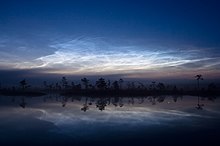
Back غيوم متألقة ليلا Arabic Gümüşü buludlar Azerbaijani Серабрыстыя воблакі Byelorussian Сребристи облаци Bulgarian Núvol noctilucent Catalan Noční svítící oblak Czech Cymylau nosloyw Welsh Lysende natsky Danish Leuchtende Nachtwolke German Φωτεινό νέφος Greek
| Noctilucent clouds | |
|---|---|
 | |
| Abbreviation | NLC/PMC |
| Altitude | 76,000 to 85,000 m (250,000 to 280,000 ft) |
| Classification | Other |
| Precipitation | No |
Noctilucent clouds (NLCs), or night shining clouds,[1] are tenuous cloud-like phenomena in the upper atmosphere of Earth. When viewed from space, they are called polar mesospheric clouds (PMCs), detectable as a diffuse scattering layer of water ice crystals near the summer polar mesopause. They consist of ice crystals and from the ground are only visible during astronomical twilight. Noctilucent roughly means "night shining" in Latin. They are most often observed during the summer months from latitudes between ±50° and ±70°. Too faint to be seen in daylight, they are visible only when the observer and the lower layers of the atmosphere are in Earth's shadow, but while these very high clouds are still in sunlight. Recent studies suggest that increased atmospheric methane emissions produce additional water vapor through chemical reactions once the methane molecules reach the mesosphere – creating, or reinforcing existing noctilucent clouds.[2]
They are the highest clouds in Earth's atmosphere, located in the mesosphere at altitudes of around 76 to 85 km (249,000 to 279,000 ft).
© MMXXIII Rich X Search. We shall prevail. All rights reserved. Rich X Search